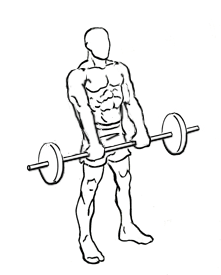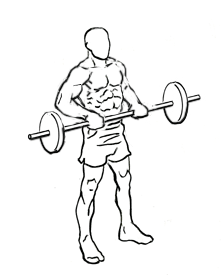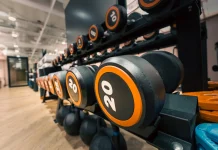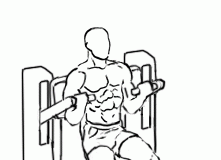Last Updated on September 30, 2022
If you’re looking for an exercise that targets your biceps like no other, the drag curl with a barbell should be on your radar. Made popular by Vince Gironda, the legendary “Iron Guru,” this workout isolates the biceps and forearms while helping you achieve that strong, defined upper arm look. Unlike traditional curls, the drag curl shifts the focus away from using momentum and instead emphasizes the contraction of your biceps for an effective pump. In this guide, we’ll break down everything you need to know about this classic exercise, from its benefits to proper form and common mistakes to avoid.
Why Do the Drag Curl?
The drag curl offers several benefits, making it a valuable addition to any strength-training routine.
1. Isolates the Biceps More Effectively
Unlike standard barbell curls, the drag curl puts more emphasis on the biceps by reducing the involvement of other muscle groups. The result is a more focused workout that targets the upper arm muscles, leading to improved muscle growth and strength.
2. Builds Forearm Strength
While the drag curl is a bicep-focused movement, it also works the forearms, offering a balanced development of your entire arm. Building your forearms is critical for improving your grip strength, which will help you lift heavier weights over time.
3. Reduces Momentum
Because the drag curl eliminates shoulder and elbow movement, it prevents you from using momentum to lift the weight, which is common with standard curls. This helps ensure your biceps are doing all the work, making the exercise much more effective for muscle development.
4. Unique Muscle Stimulation
The drag curl forces your arms into a different plane of motion compared to traditional curls. This slight shift in biomechanics gives your muscles a fresh challenge, making the exercise particularly useful for overcoming plateaus in your bicep training.
Muscles Worked in the Drag Curl
While this exercise primarily targets the biceps brachii, it also works other muscles to a lesser extent. Here’s a breakdown of the muscles involved:
- Biceps Brachii: The main muscle worked, responsible for flexing the elbow and rotating the forearm.
- Brachialis: A muscle underneath the biceps that helps flex the elbow, providing depth to the upper arm.
- Brachioradialis: Located in the forearm, this muscle assists in elbow flexion and helps build forearm strength.
- Forearm Flexors: The forearms play a secondary role in gripping and stabilizing the barbell during the exercise.
How to Perform the Drag Curl with Barbell
Performing the drag curl correctly is essential for ensuring you get the most out of this bicep-building exercise while minimizing the risk of injury. Here’s a step-by-step guide to mastering the movement:
1. Set Up
Stand with your feet about shoulder-width apart. Your knees should be slightly bent to keep your stance strong and stable throughout the exercise. Engage your core by drawing your abs in, which will help stabilize your torso and prevent any unwanted movement during the lift.
2. Grip the Bar
Grasp the barbell with an underhand grip (palms facing up) at shoulder width. Ensure your grip is firm but not too tight, allowing you to focus on contracting your biceps instead of relying on your grip strength. Your arms should be fully extended, and the barbell should rest against your thighs.
3. Start the Curl
To initiate the curl, slowly pull the barbell upward by dragging it along your torso. This is where the drag curl differs from the standard curl. Instead of allowing your elbows to flare outward or your shoulders to rotate, keep them locked in place. Focus on pulling your elbows straight back as you lift the barbell toward your chest.
4. Reach the Top
Continue dragging the barbell upward until it reaches your upper chest. At this point, you should feel a significant contraction in your biceps. Remember, the key to this exercise is maintaining proper form—don’t let your elbows move forward, and avoid using your shoulders to lift the weight.
5. Lower the Barbell
Once you’ve reached the top, slowly lower the barbell back down to the starting position by reversing the movement. Again, keep the bar as close to your torso as possible, resisting the urge to let gravity pull the weight down quickly. Lowering the bar with control helps maintain tension on your biceps, making the exercise more effective.
6. Repeat
Perform 8-12 repetitions per set, depending on your training goals. For building muscle mass, aim for 3-4 sets of 8-12 reps. If you’re focusing on increasing strength, you may want to perform fewer reps with heavier weights.
Key Tips for Proper Form
To get the best results from the drag curl and avoid injury, keep these form tips in mind:
- Keep your elbows stationary: Your elbows should remain close to your body and move straight backward during the lift. Don’t let them flare outward or rotate forward.
- Avoid using your shoulders: The goal of this exercise is to isolate the biceps, so resist the urge to involve your shoulders in the movement. Keep them down and back.
- Move slowly and with control: The drag curl isn’t about speed. Move the barbell slowly to maintain tension in your biceps throughout the entire range of motion.
- Don’t go too heavy: Since this exercise isolates the biceps more than other curls, you won’t be able to lift as much weight as you can with standard barbell curls. Focus on using a weight that allows you to complete each rep with perfect form.
Common Mistakes to Avoid
Even though the drag curl might seem like a straightforward exercise, there are a few common mistakes that can compromise your results or lead to injury.
1. Moving the Elbows Forward
One of the most common mistakes is allowing the elbows to move forward as you lift the barbell. This not only shifts the focus away from the biceps but also reduces the effectiveness of the exercise. Keep your elbows locked in place and focus on dragging them backward.
2. Using Momentum
It’s tempting to swing the weight up, especially when using heavier loads, but this takes tension off your biceps and puts unnecessary strain on your shoulders and lower back. Always perform the exercise with a controlled, steady pace.
3. Going Too Heavy
Because the drag curl isolates the biceps more than traditional curls, you may not be able to lift as much weight. Trying to lift too heavy can lead to poor form and increase the risk of injury. Focus on form first and progressively increase the weight as you become stronger.
4. Not Engaging the Core
A weak or disengaged core can result in poor posture during the exercise, leading to strain on your lower back. Keep your abs engaged throughout the movement to protect your spine and maintain stability.
Variations of the Drag Curl
Once you’ve mastered the basic drag curl with a barbell, you can incorporate variations to keep your workouts interesting and continue challenging your muscles.
1. Dumbbell Drag Curl
If you want to work on muscle imbalances or increase the range of motion, try performing the drag curl with dumbbells. This variation allows for more freedom of movement and can help improve your coordination.
2. Cable Drag Curl
Using a cable machine for drag curls can provide constant tension on your biceps throughout the entire range of motion. This variation is excellent for achieving a solid pump and adding variety to your bicep routine.
3. Smith Machine Drag Curl
The Smith machine provides additional stability, making it easier to maintain proper form. This can be useful if you’re new to the exercise or want to focus on perfecting your technique.
Incorporating Drag Curls into Your Workout
To get the most out of drag curls, it’s important to know where and how to fit them into your training routine. Here are a few ideas:
- As a finisher: Since the drag curl isolates the biceps, it makes an excellent finisher after you’ve completed your heavy compound lifts like rows or pull-ups.
- Superset with other bicep exercises: Pair the drag curl with exercises like hammer curls or concentration curls to fully fatigue the biceps and maximize your gains.
- On arm day: If you have a dedicated arm workout, drag curls can be included as one of your primary bicep exercises to mix things up and hit the muscles from a different angle.
The Drag Curl for Bigger, Stronger Biceps
The drag curl with a barbell is a highly effective exercise for isolating and building the biceps. Whether you’re a beginner looking to increase arm size or an experienced lifter trying to overcome a bicep plateau, this exercise offers unique muscle stimulation and growth potential. Remember to focus on proper form, avoid common mistakes, and progressively challenge yourself with heavier weights as your strength improves. Add the drag curl to your routine today, and watch your biceps grow like never before!








